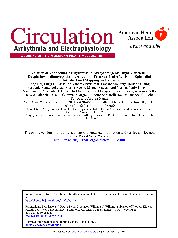摘要
Background-In patients with arrhythmogenic right ventricular dysplasia/cardiomyopathy, freedom from ventricular arrhythmias (VAs) after endocardial ablation is limited. We compared the long-term freedom from recurrent VAs by using endocardial-alone ablation versus endo-epicardial substrate-based ablation.
Methods and Results-Forty-nine patients with arrhythmogenic right ventricular dysplasia/cardiomyopathy undergoing ablation of ventricular tachycardia (VT) were divided into 2 groups: endocardial-alone ablation (group 1, n = 23) and endo-epicardial ablation (group 2, n = 26). All patients had an implantable cardioverter-defibrillator (ICD). Conventional and 3D mappings were used to determine the mechanism of induced VTs and to identify area of "scar" or "abnormal" myocardium. All critical sites responsible for VTs and points with "abnormal" potential were targeted for ablation from endocardium (group 1) or from both endocardium and epicardium (group 2). The procedural end point was noninducibility of sustained, monomorphic VT with isoproterenol. The presence of frequent premature ventricular contractions at the end of ablation was recorded. Patients were followed up by ECG, Holter, and ICD interrogation. After a follow-up of at least 3 years, freedom from VAs or ICD therapy was 52.2% (12/23) in group 1 and 84.6% (22/26) in group 2 (P = 0.029), with 21.7% (5/23) and 69.2% (18/26) patients off antiarrhythmic drugs (P<0.001), respectively. Compared with patients with no premature ventricular contractions after ablation, patients with frequent premature ventricular contractions after ablation were more likely to have VA recurrence/ICD therapy [3/33 (9%) versus 12/16 (75%); log-rank P<0.001].
Conclusions-An endo-epicardial-based ablation strategy achieves higher long-term freedom from recurrent VAs off antiarrhythmic therapy in patients with arrhythmogenic right ventricular dysplasia/cardiomyopathy when compared with endocardial-alone ablation. The presence of >= 10 premature ventricular contractions per minute after ablation is associated with more VA recurrence. (Circ Arrhythm Electrophysiol. 2011; 4: 478-485.)
- 出版日期2011-8
- 单位华中科技大学
